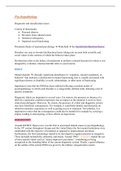Summary
Summary Psychopathology - Year 3 Psychology VU Amsterdam
- Course
- Institution
This is the summary for the course of psychopathology and prevention for the third year of the bachelor in psychology. It is based on the content from the lectures as well as the literature provided throughout the course. For this course I had gotten an 8.
[Show more]



